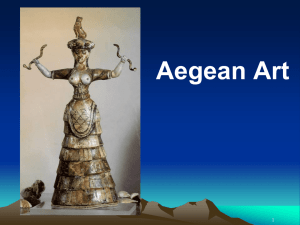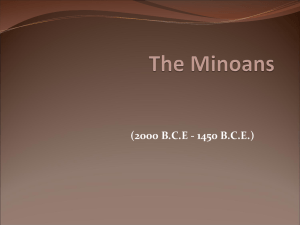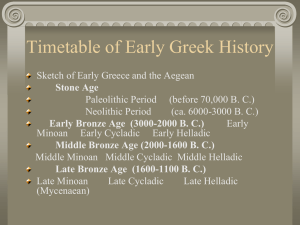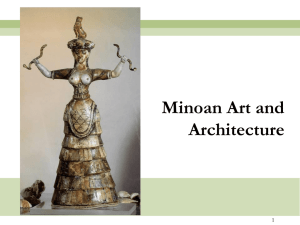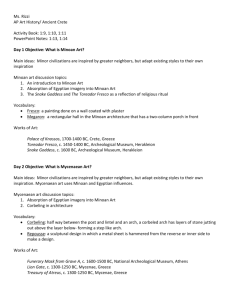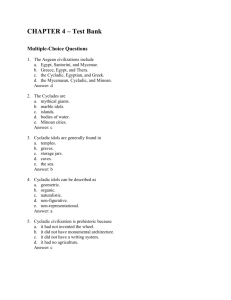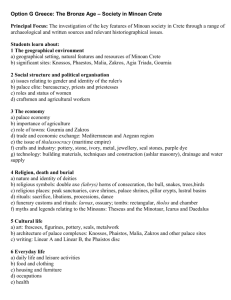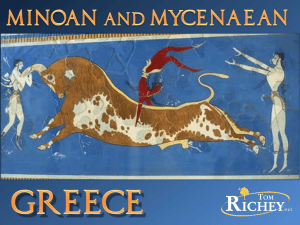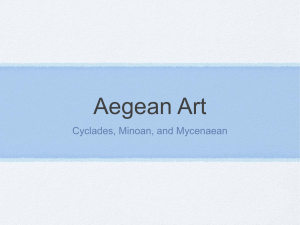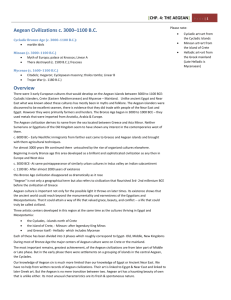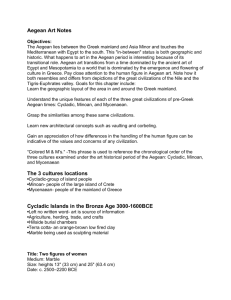Ancient Aegean Notes
advertisement
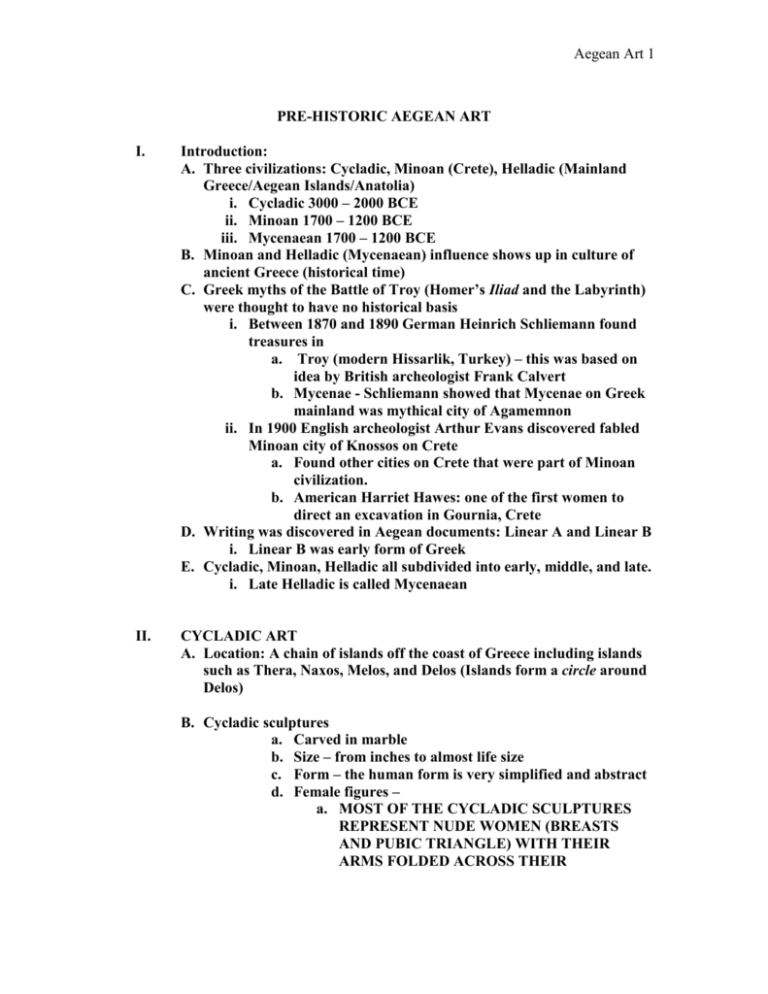
Aegean Art 1 PRE-HISTORIC AEGEAN ART I. Introduction: A. Three civilizations: Cycladic, Minoan (Crete), Helladic (Mainland Greece/Aegean Islands/Anatolia) i. Cycladic 3000 – 2000 BCE ii. Minoan 1700 – 1200 BCE iii. Mycenaean 1700 – 1200 BCE B. Minoan and Helladic (Mycenaean) influence shows up in culture of ancient Greece (historical time) C. Greek myths of the Battle of Troy (Homer’s Iliad and the Labyrinth) were thought to have no historical basis i. Between 1870 and 1890 German Heinrich Schliemann found treasures in a. Troy (modern Hissarlik, Turkey) – this was based on idea by British archeologist Frank Calvert b. Mycenae - Schliemann showed that Mycenae on Greek mainland was mythical city of Agamemnon ii. In 1900 English archeologist Arthur Evans discovered fabled Minoan city of Knossos on Crete a. Found other cities on Crete that were part of Minoan civilization. b. American Harriet Hawes: one of the first women to direct an excavation in Gournia, Crete D. Writing was discovered in Aegean documents: Linear A and Linear B i. Linear B was early form of Greek E. Cycladic, Minoan, Helladic all subdivided into early, middle, and late. i. Late Helladic is called Mycenaean II. CYCLADIC ART A. Location: A chain of islands off the coast of Greece including islands such as Thera, Naxos, Melos, and Delos (Islands form a circle around Delos) B. Cycladic sculptures a. Carved in marble b. Size – from inches to almost life size c. Form – the human form is very simplified and abstract d. Female figures – a. MOST OF THE CYCLADIC SCULPTURES REPRESENT NUDE WOMEN (BREASTS AND PUBIC TRIANGLE) WITH THEIR ARMS FOLDED ACROSS THEIR Aegean Art 2 ABDOMENS. Example: Woman from Syros: Marble, 18” high, 2500 – 2300 BCE. b. The statues feet are too fragile to support the figurine. Archaeologists speculate that the statues must have been placed on their backs in graves, lying down on the deceased themselves. c. Whether they represent those buried or fertility figures or goddesses are still debated. d. The figures were partly painted (eyes, mouths, necklaces, and bracelets) e. Male figures are less frequent and often take the form of seated musicians. The male figures contain OPEN FORMS (notice arms extended and open spaces) while the females have CLOSED FORMS. Example: Male Lyre Player, Keros, Greece, 2700 – 2500 BCE, Marble, 9” high f. Cycladic statues at the MET – The Met has a particularly good collection of the Cycladic sculpture located in its Greek and Roman Galleries g. History of Cycladic art may never be fully known. Many sources of Cycladic art have been plundered by smugglers. Without info about original context (provenance = discovery info and documented chain of evidence) of piece impossible to recreate what the artifacts mean. Forgeries are common. h. Male and female figures found in same grave. Maybe the male musician will provide music in afterlife? Not sure if figures represent the deceased. III. MINOAN ART: Crete A. A Famous Legend a. Zeus, Europa, and Minos a. Europa – a beautiful princess from Palestine b. Zeus fell in love with Europa. Zeus appeared to her first in the shape of a bull and later as an eagle c. Europa bore Zeus several sons including one named Minos b. Minos a. Established a fabulous and powerful kingdom on Crete b. Commanded a large navy and swept the sea of pirates Aegean Art 3 c. Exacted a heavy tribute from the conquered cities along the coast of the Aegean Sea i. Every year Athens was forced to send him a ship with 7 young men and 7 young women to sacrifice to the Minotaur ii. Who was the Minotaur? The Minotaur was a monster that was half human and half bull. d. Minos and the Minotaur i. Minos broke an oath to Poseidon, god of the sea, who had guaranteed his kingship ii. In revenge, Poseidon caused Minos’ wife to fall in love with a bull. The offspring of their unnatural union was the Minotaur iii. Labyrinth – Minos had Daedelus build a Labyrinth, a complex maze, to hold the Minotaur. It was so diabolically intricate in construction that no one could find a way out again. Hence the word labyrinthine, which means very complex and convoluted iv. The Minotaur would make horrible roaring sounds, and could only be appeased by these young sacrifices c. Theseus and Aegeus a. Aegeus – king of Athens b. Theseus – his intrepid son. Handsome, brave, and daring c. An audacious plan d. An important signal upon returning i. Black sails if unsuccessful ii. White sails if successful d. Theseus and Ariadne a. Beautiful daughter of King Minos b. Fell in love with Theseus c. Gave Theseus a ball of thread so he could find his way out of the twisting passages of the labyrinth e. Theseus and the Minotaur a. Kills the Minotaur b. Escapes with Ariadne c. Abandons her on the island of Naxos Aegean Art 4 d. Returns to Athens but forgets to changed the sails on his ship e. Despondent King Aegeus jumps off a cliff into the sea. Aegean Sea is named for him B. Arthur Evans and the Legends 1. Arthur Evans a. A British scholar b. Enchanted by the legends c. Could there be a forgotten civilization? 2. Knossos a. A seemingly insignificant Cretan village b. With a suspicious big tell (mound of earth) 3. Discoveries a. Strange marks of a long dead and long forgotten civilization b. A huge and complex palace 1. Three-stories tall 2. Columns similar to the Doric order but a little different 3. Major courtyard 4. Imagery of bulls – frescoes and altar with horns (Minotaur?) 5. A large hall with many walls and columns (Labyrinth?) c. Walls covered with long buried FRESCOES (paintings on wet plaster) C. Architecture a. Size and Geography a. No large river valleys b. Jumbled hills, ragged limestone peaks c. Abundant sunlight, adequate rain, and fertile if rocky soil d. Wine and olive oil e. As an island, fishing and trade were important f. During 3rd millennium BCE only small settlements on mainland Greece and Aegean Islands. Dead buried without costly offerings. g. Construction of large palaces in 2nd millennium marks beginning of Middle Minoan period on Crete. b. Palace at Knossos a. Old Palace destroyed around 1700 BCE due to earthquake. b. Rebuilt quickly Aegean Art 5 c. New Palace marks beginning of Late Minoan period. d. Palace in Knossos and other cities on Crete. Had similar layouts. i. Comfortable ii. Residence for king and his family iii. Courtyards for pageants, ceremonies, games iv. Storerooms, offices, and shrines v. Functioned as commercial, religious, and administrative centers of city. e. Palace at Knossos i. Home of legendary King Minos ii. See story of Minos, Theseus, Ariadne iii. Symbol of Minos’ Palace was doubleheaded axe = labrys = reference to sacrificial slaughter. Labrys symbol all over palace rooms. iv. Palace was complex, rambling structure (thus labyrinth = maze in English).Built on hill and slopes. As many as 3 levels. v. Elite lived in mansions around palace. vi. New palace was carefully planned to provide light and air; drainage pipes under building. vii. Thick walls of fieldstones embedded in clay. Rubble walls covered on the inside with plaster. viii. Painted wooden columns: distinctive. Bulbous, cushion-like capitals; Columns like inverted tree trunks – taper wide top to narrow base – opposite of Egyptian and Greek. D. Minoan Frescoes: True (wet) frescos – pigment mixed into wet plaster. Had to work quickly before plaster set. VS Egyptian fresco – fresco secco (dry) – is not part of wall, on top of surface, not as permanent. 1. Refined images of ladies a. Minoan woman or goddess (La Parisienne) 1. Elaborate hair style 2. Elegant dress 3. Pronounced red lips – significant life-like qualities 4. Conventional – frontal eye and profile b. Handsome and athletic men Aegean Art 6 2. Nature a. Dolphins b. Monkeys c. Antelopes 3. Seascapes and fishing scenes a. Flotilla from Miniature Ships Fresco (Thera) 5. Boxing 6. Bull-leaping from the palace at Knossos a. Vivacity and a sense of life b. Young women with fair skin participate (note their long curly hair) c. Athletic young man doing a flip over the bull while in motion d. Similar to Egyptian and Mesopotamian art but has a greater sense of animation e. Elongated bodies have sense of living and moving (think animation characters with squash and stretch). 7. Thera (Santorini) Frescos a. Possibly in Minoan orbit b. Better preserved due to being buried by volcanic ash. c. Landscape with swallows (from Thera) Spring Fresco 1. First known LANDSCAPE – no humans, no narrative elements 2. Plants and land are not realistic – flow gracefully with a rhythm E. Minoan pottery and sculpture 1. Sea life on pottery - Kamares War jar, ca. 1800 – 1700 BCEPhaistos, white on dark a. A leaping fish (maybe a forerunner to dolphin frescoes b. Maybe a net being thrown near it c. Curvilinear, abstract patterns give a flow and rhythm to the painting 2. Marine Style, Octopus Jar, Palaikastro, ca. 1500 BCE, Reverse doark on white. Remained dominant style until 500 BCE. a. Notice the flowing organic lines of the octopus and its tentacles (similar to bull-leaping and Spring Fresco) 3. Harvester Vase, from Hagia Triada, ca. 1500 BCE, Steatite, 5” diameter a. Figures are shown dancing and playing musical instruments b. Main figure is very prominent – First instance of an artist showing major interest in the muscles and underlying structures of HUMAN ANATOMY Aegean Art 7 4. Snake Goddess, Knossos, ca. 1600 BCE, Gaience, 13.5” high a. Most likely is a goddess figure b. Frontality like Egyptian and Near Eastern art c. Open bodice and animated figure – Minoan features 5. Sarcophagus, 1800 – 1700 BCE, 54” long, Painted Limestone, a. Similar to Minoan frescos but subject is funerary practices. Gives info on religious beliefs. IV. Mycenae – Treasures and Wonders 1. Mycenae flourished from 1600 – 1200 BCE, after the eruption of Thera, an island in the Cyclades a. Mycenae was a citadel, a walled city, situated in the mountains and had massive fortifications b. How does this compare to the Minoan palaces? 2. Lion’s Gate a. Famous, main entrance to Mycenae b. Two 9’ lions positioned in the RELIEVING TRIANGLE guard the entrance (they may have had bronze heads which are now missing) c. Huge stones that weigh 20 tons d. Greeks thought that no human could have lifted the stones attributed the building of Mycenae’s walls to the Cyclops. To this day, art historians refer to the walls of Mycenae as CYCLOPEAN MASONRY. e. The entrance is supported by POST AND LINTEL CONSTRUCTION f. The relieving triangle was created through a technique developed by Mycenaean civilization called the CORBELLED ARCH. 3. THOLOI (tombs) a. A THOLOS is a Mycenaean tomb that has a beehive dome shape b. Under ground, the tomb is supported through corbelled stones and buried underground. The earth on top of the tomb reinforces its support c. Mycenaean royal families and nobles were buried in tholoi d. Larger than it looks – 43’ high 4. Megaron – royal audience hall Aegean Art 8 a. Probably covered with frescoes b. Entered through a porch supported by two columns, passed the antechamber to the throne room which had a huge hearth surrounded by columns 5. Mycenaean painting – most famous surviving fresco is “Goddess” a. Also on pottery – Famous Warrior Vase b. Painted sculpture – Female head from Mycenae (painted plaster) i. May be the head of a goddess or a sphinx ii. Paint marks on her face may be tattoos iii. Intense gaze would be appropriate for a guardian figure similar to small terracotta images of goddesses found in Mycenaean shrines iv. Rare example of monumental sculpture from this period 7. Golden treasures c. Golden crown d. Signet rings e. Golden jewelry f. Gold-handled sword g. Inlaid dagger blade showing a lion hunt h. Golden burial masks i. An ecstatic Heinrich Schliemann upon discovering this mask telegraphed the following message to the King of Greece: “I have gazed on the face of Agamemnon!” ii. Masks are sculpted repousse
